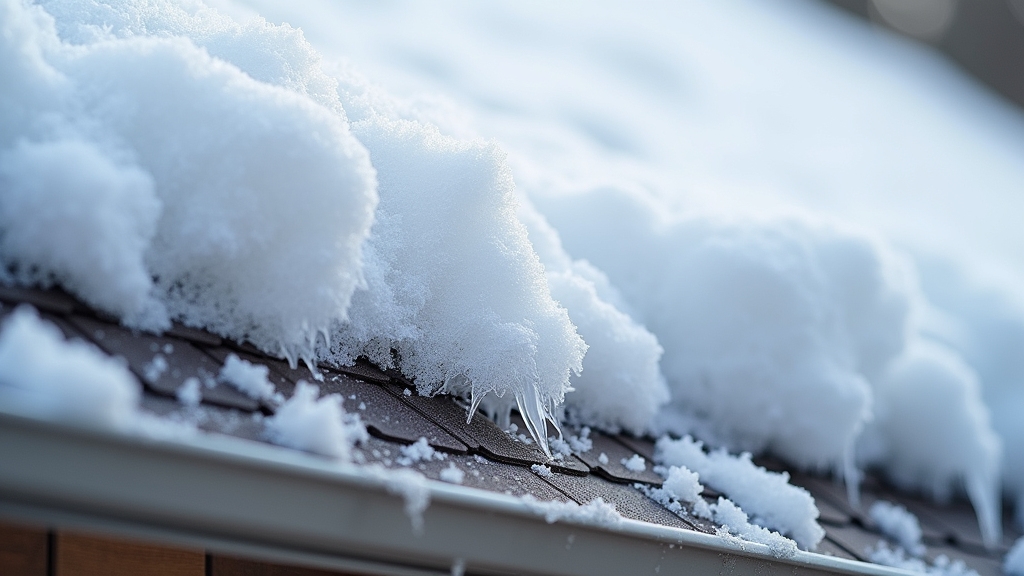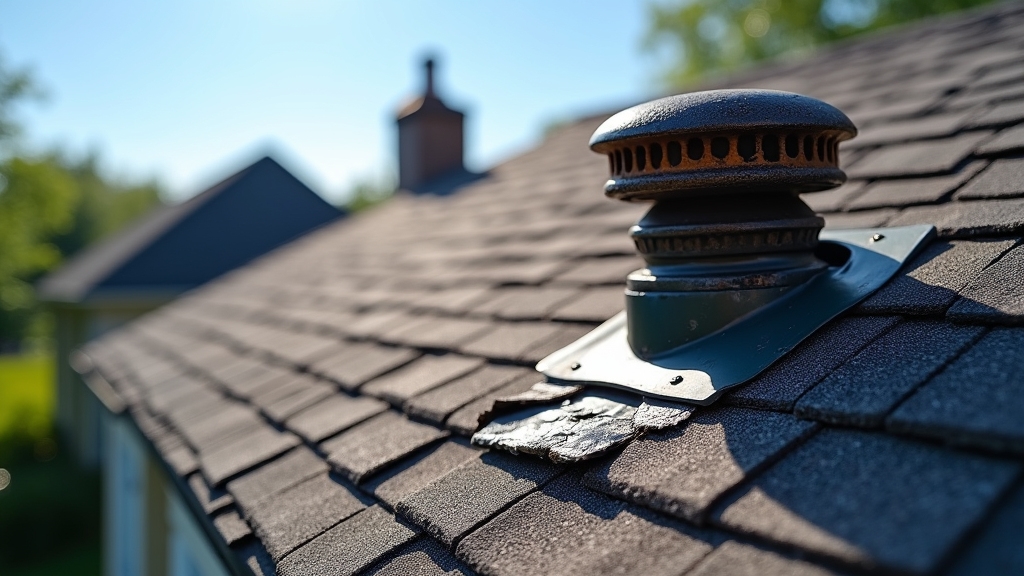Weather in Michigan poses unique challenges to roofing longevity. Heavy snowfall can exceed load limits, leading to structural failure. Ice dams may form, causing water infiltration and leaks. In summer, high temperatures and UV exposure accelerate material degradation, while wind can cause uplift and displacement of shingles. Regular inspections and quality materials are essential for mitigating these effects. Understanding these factors can help guarantee a roof’s durability and performance in Michigan’s climate. Discover more about effective maintenance strategies.
Key Takeaways
- Severe storms and heavy snowfall in Michigan can cause significant roof damage, reducing lifespan due to excessive snow loads and ice dam formation.
- Prolonged summer heat and UV radiation accelerate deterioration of roofing materials, leading to curling and cracking that shortens lifespan.
- Regular roof inspections allow for early identification of issues, preventing minor problems from escalating into costly repairs that can affect roof longevity.
- High-quality roofing materials specifically designed for Michigan’s climate increase durability against weather-related stressors, enhancing overall roof lifespan.
- Preventative measures, such as regular gutter cleaning and proper insulation, mitigate risks associated with water pooling and ice damming, promoting a longer roof life.
The Effects of Heavy Snowfall on Roofing Materials

Heavy snowfall exerts significant pressure on roofing materials, influencing their structural integrity and longevity. When snow accumulates beyond designed load limits, it can lead to deformation or collapse of roofing systems. The weight of heavy snow, typically exceeding 20 pounds per cubic foot, can strain materials such as asphalt shingles, metal panels, and wooden structures.
Prolonged exposure to excessive snow loads may exacerbate existing weaknesses, leading to the deterioration of waterproofing membranes and increasing susceptibility to leaks.
Furthermore, the potential for thermal cycling, where fluctuating temperatures cause snow to melt and refreeze, can introduce additional stressors. This process can weaken the bonds between roofing materials, ultimately reducing their lifespan.
Regular assessment of roof load capacity and timely snow removal are essential practices for maintaining roofing integrity in snow-prone regions like Michigan, ensuring structural safety and longevity in the face of harsh winter conditions.
Ice Dams and Their Impact on Roof Integrity

Accumulation of snow on roofs can lead to the formation of ice dams, which pose a significant risk to roof integrity. These ice dams occur when melting snow refreezes at the roof’s edge, causing water to pool behind them. This trapped water can infiltrate roofing materials, leading to leaks and structural damage. Understanding the implications of ice dam formation is essential for homeowners.
| Condition | Effects on Roof | Prevention Strategies |
| Ice Dams | Water infiltration, leaks | Proper insulation and ventilation |
| Excessive Snow Load | Increased stress | Regular snow removal |
| Temperature Fluctuations | Freeze-thaw cycles | Install heat cables |
| Poor Drainage | Water pooling | Maintain gutters and downspouts |
Addressing these conditions through proactive measures can extend the lifespan of roofs and maintain their integrity amidst Michigan’s challenging winter weather.
Summer Heat and Its Toll on Roofs

Although summer heat may seem less destructive than winter storms, it can considerably impact the lifespan and performance of roofing materials in Michigan. Prolonged exposure to high temperatures can accelerate the deterioration of roofing materials such as asphalt shingles, which may soften and become brittle. This thermal stress can result in curling, cracking, and eventual loss of granules, compromising the roof’s protective qualities.
Moreover, ultraviolet (UV) radiation from the sun exacerbates this degradation, leading to oxidative damage and reduced flexibility. Roofs may also experience thermal cycling, where rapid temperature fluctuations between day and night induce expansion and contraction, further weakening material integrity.
Additionally, the accumulation of heat can raise attic temperatures, resulting in increased energy costs and potential damage to insulation. Proper ventilation and reflective roofing options can mitigate these adverse effects, ultimately enhancing the longevity and performance of roofs in Michigan’s summer heat.
Wind Damage: How Storms Affect Your Roof
Wind damage considerably impacts roofing durability, particularly in regions prone to severe storms.
Understanding the types of wind damage, implementing preventative measures, and recognizing signs of roof wear are critical for maintaining roof integrity.
This discussion will outline these essential aspects to help homeowners safeguard their investments against the effects of high winds.
Types of Wind Damage
Severe weather events can considerably impact the integrity of a roof, with various types of wind damage posing distinct threats.
Uplift damage occurs when strong winds generate pressure differences, lifting shingles or even entire roof sections, exposing underlying materials to moisture.
Shearing damage, characterized by the lateral force of winds, can dislodge shingles, compromising their protective barrier.
Additionally, wind-driven debris can cause punctures and tears in roofing materials, leading to greater vulnerability.
Moreover, continuous gusts can exacerbate existing weaknesses, magnifying the risk of long-term degradation.
Understanding these types of wind damage is essential for homeowners and roofing professionals alike, facilitating informed decisions regarding maintenance and repairs to prolong a roof’s lifespan amid Michigan’s unpredictable weather patterns.
Preventative Measures to Consider
As storms can escalate rapidly in Michigan, homeowners must adopt preventative measures to safeguard their roofs against potential wind damage.
First, securing roof shingles with adhesive or mechanical fasteners can enhance resistance to uplift forces. Regular inspections should be conducted to identify loose or damaged shingles, ensuring timely repairs.
Additionally, tree maintenance is critical; overhanging branches should be trimmed to prevent wind-driven debris from impacting the roof. Installing a roof with a suitable pitch can also mitigate wind load effectively.
Homeowners should consider investing in impact-resistant roofing materials that withstand severe conditions.
Finally, ensuring proper ventilation and insulation within the attic can help maintain structural integrity, reducing the likelihood of wind-related issues during storms.
Signs of Roof Wear
Roof wear often becomes evident after considerable storm activity, particularly in regions like Michigan where high winds are common. The impact of wind on roofing materials can manifest in various ways, necessitating a keen observation for signs of damage. Homeowners should be vigilant for specific indicators, which can be categorized as follows:
| Sign of Wear | Description | Recommended Action |
| Missing Shingles | Shingles that are entirely absent | Replace immediately |
| Curling Edges | Shingles with upward curling edges | Assess for full replacement |
| Granule Loss | Visible loss of granules from shingles | Inspect and repair |
| Cracked Shingles | Fractures indicating structural fatigue | Replace as needed |
| Leaks | Water infiltration points | Professional inspection |
Recognizing these signs early can considerably prolong a roof’s lifespan.
The Importance of Regular Roof Inspections
Although often overlooked, regular roof inspections are crucial for maintaining the integrity and longevity of residential and commercial buildings in Michigan. The state’s variable weather conditions, including heavy snowfall, ice, and high winds, can greatly accelerate roof deterioration.
Routine inspections allow for early identification of potential issues such as compromised shingles, structural weaknesses, and water infiltration. Timely detection is critical; minor problems can escalate into costly repairs if left unaddressed.
Moreover, inspections conducted by qualified professionals guarantee compliance with local building codes and standards, which is particularly important in Michigan’s diverse climate.
Additionally, regular inspections can enhance insurance claims and bolster property value by demonstrating proactive maintenance. As roofs are a considerable investment, confirming their condition through systematic evaluations is crucial for safeguarding against Michigan’s unpredictable weather and extending overall roof lifespan.
Tips for Roof Maintenance in Michigan’s Climate
To effectively maintain a roof in Michigan’s challenging climate, homeowners must adopt a proactive approach that addresses the unique weather-related stressors present throughout the year.
Regular inspections are essential, particularly after severe storms or heavy snowfall, to assess for damage such as missing shingles or ice dam formation. Preventative measures, including gutter cleaning and guaranteeing proper drainage, mitigate water accumulation, which can lead to leaks and structural issues.
Additionally, applying reflective coatings can help combat the summer heat, while guaranteeing adequate insulation reduces the risk of ice damming in winter.
Homeowners should also schedule professional evaluations every few years to identify potential weaknesses in materials or installation. Utilizing high-quality roofing materials designed for Michigan’s climate enhances durability and lifespan.
Finally, maintaining clear communication with roofing professionals guarantees timely repairs and informed decisions regarding roof replacement when necessary.
Frequently Asked Questions
How Often Should I Replace My Roof in Michigan?
In Michigan, homeowners should consider replacing their roofs every 20 to 25 years. Factors such as material, maintenance, and exposure to severe weather can influence this timeline, necessitating inspections for ideal performance and longevity.
What Roofing Materials Are Best for Michigan’s Climate?
Asphalt shingles, metal roofing, and synthetic materials are ideal for Michigan’s climate. These options provide durability against extreme temperatures, heavy snowfall, and ice damming, ensuring longevity and reliability under varying weather conditions prevalent in the region.
Can I Install a Roof in Winter?
Roof installation during winter is feasible, provided specific precautions are taken. Cold-weather adhesives and materials designed for low temperatures guarantee proper adhesion and performance, mitigating risks associated with freezing conditions and guaranteeing structural integrity throughout the installation process.
How Does Humidity Affect My Roof’s Lifespan?
Humidity can greatly affect a roof’s lifespan by promoting mold growth, weakening materials, and accelerating deterioration. High moisture levels lead to structural issues, while prolonged exposure can compromise the integrity of roofing systems and materials.
Are There Specific Warranties for Roofs in Michigan?
Specific warranties for roofs in Michigan vary by manufacturer, often covering materials and workmanship for 20 to 50 years. Climate-specific considerations may influence warranty terms, emphasizing the importance of selecting appropriate roofing systems for local conditions.
Final Thoughts
Michigan’s unpredictable weather — from heavy snowfall and ice dams to scorching summer heat and high winds — can significantly shorten your roof’s lifespan if not properly managed. Each season introduces unique stressors that test your roof’s durability, making routine inspections and proactive maintenance essential for long-term protection. Investing in high-quality roofing materials designed to withstand Michigan’s harsh climate can dramatically reduce wear, improve energy efficiency, and enhance your home’s overall safety.
For expert roof care, trust 180 CONTRACTORS ROOFING STERLING HEIGHTS — your local roofing specialists serving Sterling Heights, Troy, Rochester Hills, and Warren.
Our experienced team provides complete roof inspections, repairs, and replacements, using durable materials such as asphalt shingles and metal roofing that perform exceptionally in Michigan’s climate.
Call (586) 331-0594 or contact us online today to schedule your free roof inspection or estimate. Let 180 CONTRACTORS help protect your home from Michigan’s toughest weather — with reliable roofing solutions built to last.
